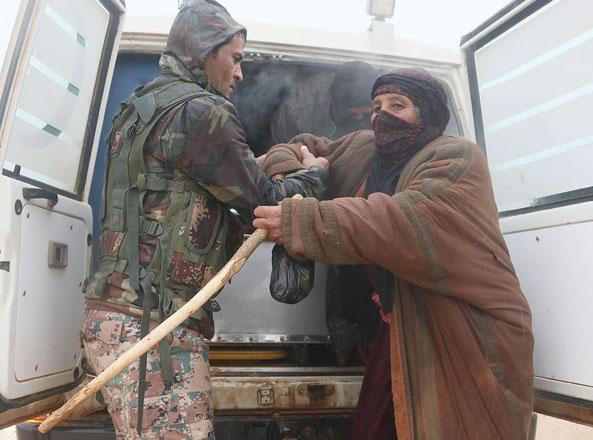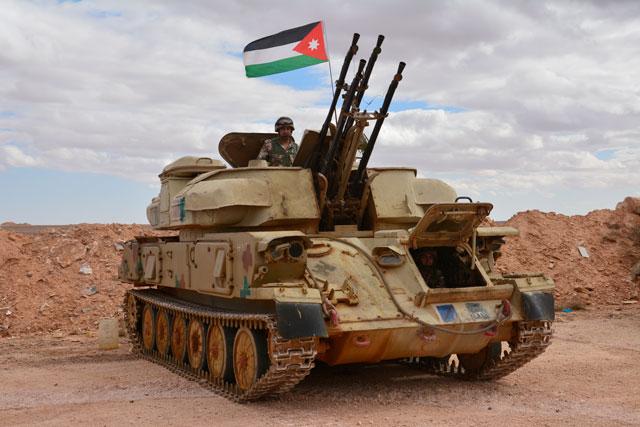You are here
Integrated electronic system gives army best insight into border threats — general
By JT - Mar 04,2017 - Last updated at Mar 04,2017

In this undated photo, a soldier helps an elderly woman seeking refuge in Jordan (Petra photo)
AMMAN — Border Guards have human resources and an electronic system constantly updated to monitor the entire Jordanian turf and an additional range extending for tens of kilometres across its borders, a senior army officer said.
In an interview with the Jordan News agency, Petra, on Saturday, Commander of the First Border Guard Corps Brig. Gen. Barakat Ajarmeh stated that troops are prepared to deal with any emergencies and capable of preventing infiltrators, whether terrorists or smugglers.
The political decision to seal the northern and northeastern borders and prevent refugees from entering the Kingdom, except special humanitarian cases, "is justifiable", he said. In these exceptional cases, refugees go back to their camps across the borderline after necessary measures are taken.
On June 21, Jordan declared the northern and northeastern border areas sealed military zones after a terrorist attack targeted a forward military post that served Syrian refugees on the northeastern front close to the Rakban Camp.
The attack by a booby-trapped car resulted in the death and injury of several troops.
“We coordinate with the [Syrian] tribal army leader, which is an unofficial party that undertook the responsibility to protect the safety and stability of asylum seekers in Rakban, currently inhabited by an estimated 70,000 people and counting,” Ajarmeh told Petra.
He added that the leader of the “tribal army”, which is comprised of tribesmen from the Syrian eastern desert, is considered as a key authority for camp dwellers. The border units contacted this person to serve those seeking refuge from the camp and help secure their needs, provide them with necessary medical treatment, and facilitate the work of and protect relief workers from humanitarian organisations .
Border Guards facilitate the provision of humanitarian aid to the displaced Syrians around the clock, including around 400 cubic metres of water per day, under the supervision of the Jordan Armed Forces-Arab Army (JAF) command, Ajarmeh said, noting that all agency personnel are searched before entering the borders as well as while on duty, and that patients are also subject to inspection after their arrival from the Rakban and the Hadalat camps further east. Aid shipments are also inspected entirely, the officer noted.
The troops treat patients as soon as they arrive at the border, especially women and children; they refer critical cases to nearby public hospitals and send them back to their camps after their health improves, the general said.
For her part, UNHCR’s senior operations manager Maeve Murphy last Wednesday expressed her concerns for the harsh living conditions of the Syrians stranded in the no-man’s-land.
JAF officers help transport the asylum seekers into health centres close to the borders, Murphy confirmed, noting that a medical centre was established on December 15, 2016, on the Jordanian-Syrian border to offer medical care to the inhabitants of the camp.
The aid provided to Rakban dwellers came to a halt between June and November last year, following the said terrorist attack, apart from a one-time shipment delivered in August, she told Petra.
Since December 15, 2016, up to the time of her interview, Murphy said that 785 patients had been treated and that more than 50 admitted into public hospitals, adding that 148 children had been examined, including 19 who were diagnosed with severe malnourishment.
She said the centre also provides newborns with clothes and hygiene items, stressing that 66 per cent of the aid provided to Rakban and Hadalat dwellers went to women and children.
Preparations are still ongoing for a second round of humanitarian aid in the two areas. Moreover, in response to a request by the Border Guards, the International Organisation for Migration installed thermal cameras to monitor the camp areas.
Related Articles
RAKBAN — In an arid land 500 kilometres from Amman lies the northeastern border with Syria, where the Rakban refugee camp emerged into exist
AMMAN — State Security Court (SSC) Attorney General Brigadier General Ziad Odwan on Tuesday announced that the SSC prosecution office has re
AMMAN — Border Guards have not refused a sick Syrian child entry from Rakban camp into Jordan, an official from the Jordan Armed Forces-Arab
















